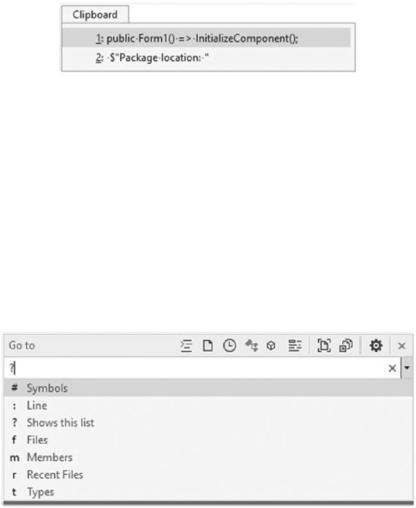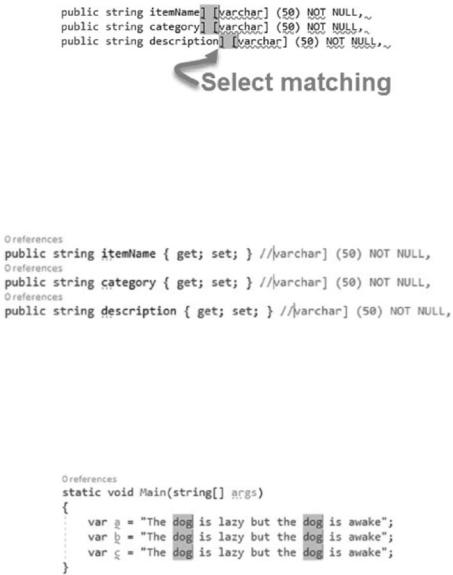
- •Table of Contents
- •About the Author
- •About the Technical Reviewer
- •Acknowledgments
- •Introduction
- •Installing Visual Studio
- •Visual Studio 2022 System Requirements
- •Operating Systems
- •Hardware
- •Supported Languages
- •Additional Notes
- •Visual Studio Is 64-Bit
- •Full .NET 6.0 Support
- •Using Workloads
- •The Solution Explorer
- •Toolbox
- •The Code Editor
- •New Razor Editor
- •What’s Available?
- •Hot Reload
- •Navigating Code
- •Navigate Forward and Backward Commands
- •Navigation Bar
- •Find All References
- •Find Files Faster
- •Reference Highlighting
- •Peek Definition
- •Subword Navigation
- •Features and Productivity Tips
- •Track Active Item in Solution Explorer
- •Hidden Editor Context Menu
- •Open in File Explorer
- •Finding Keyboard Shortcut Mappings
- •Clipboard History
- •Go To Window
- •Navigate to Last Edit Location
- •Multi-caret Editing
- •Sync Namespaces to Match Your Folder Structure
- •Paste JSON As Classes
- •Enable Code Cleanup on Save
- •Add Missing Using on Paste
- •Features in Visual Studio 2022
- •Visual Studio Search
- •Solution Filters
- •Visual Studio IntelliCode
- •Whole Line Completions
- •Visual Studio Live Share
- •Summary
- •Visual Studio Project Types
- •Various Project Templates
- •Console Applications
- •Windows Forms Application
- •Windows Service
- •Web Applications
- •Class Library
- •MAUI
- •Creating a MAUI Application
- •Pairing to Mac for iOS Development
- •Consuming REST Services in MAUI
- •The Complete Weather App
- •The Target Platforms
- •The Required NuGet Package
- •The Weather Models
- •The WeatherService
- •The MainViewModel
- •Registering Dependencies
- •Building the MainPage View
- •Using SQLite in a MAUI Application
- •The ToDoItem Model
- •The ToDoService
- •The MainViewModel
- •Registering Dependencies
- •Building the MainPage View
- •Managing NuGet Packages
- •Using NuGet in Visual Studio
- •Hosting Your Own NuGet Feeds
- •Managing nmp Packages
- •Creating Project Templates
- •Creating and Using Code Snippets
- •Creating Code Snippets
- •Using Bookmarks and Code Shortcuts
- •Bookmarks
- •Code Shortcuts
- •Adding Custom Tokens
- •The Server Explorer
- •Running SQL Queries
- •Visual Studio Windows
- •C# Interactive
- •Code Metrics Results
- •Maintainability Index
- •Cyclomatic Complexity
- •Class Coupling
- •Send Feedback
- •Personalizing Visual Studio
- •Adjust Line Spacing
- •Document Management Customizations
- •The Document Close Button
- •Modify the Dirty Indicator
- •Show Invisible Tabs in Italics in the Tab Drop-Down
- •Colorize Document Tabs
- •Tab Placement
- •Visual Studio Themes
- •Summary
- •Setting a Breakpoint
- •Step into Specific
- •Run to Click
- •Run to Cursor
- •Force Run to Cursor
- •Conditional Breakpoints and Actions
- •Temporary Breakpoints
- •Dependent Breakpoints
- •Dragging Breakpoints
- •Manage Breakpoints with Labels
- •Exporting Breakpoints
- •Using DataTips
- •Visualizing Complex Data Types
- •Bonus Tip
- •Using the Watch Window
- •The DebuggerDisplay Attribute
- •Evaluate Functions Without Side Effects
- •Format Specifiers
- •dynamic
- •hidden
- •results
- •Diagnostic Tools
- •CPU Usage
- •Memory Usage
- •The Events View
- •The Right Tool for the Right Project Type
- •Immediate Window
- •Attaching to a Running Process
- •Attach to a Remote Process
- •Remote Debugger Port Assignments
- •Remote Debugging
- •System Requirements
- •Download and Install Remote Tools
- •Running Remote Tools
- •Start Remote Debugging
- •Summary
- •Creating and Running Unit Tests
- •Create and Run a Test Playlist
- •Testing Timeouts
- •Using Live Unit Tests
- •Using IntelliTest to Generate Unit Tests
- •Focus IntelliTest Code Exploration
- •How to Measure Code Coverage in Visual Studio
- •Summary
- •Create a GitHub Account
- •Create and Clone a Repository
- •Create a Branch from Your Code
- •Creating and Handling Pull Requests
- •Multi-repo Support
- •Compare Branches
- •Check Out Commit
- •Line Staging
- •Summary
- •Index

Chapter 1 Getting to Know Visual Studio 2022
Figure 1-37. Clipboard history
Now you can just select the copied text that you want to paste and carry on with editing your code. The copied item also remains in the clipboard history after pasting.
Go ToWindow
So this could actually have gone under the “Navigating Code” section, but I wanted to add it here because it made more sense to discuss it as a productivity tip.
Hold down Ctrl+T and you will see the Go To window pop up. Now type a question mark, and see the options available to you as seen in Figure 1-38.
Figure 1-38. Go To window
You can view the recent files by typing in an r instead of a question mark. Also nice to note is the ability to jump to a specific line of code. You will remember earlier in the chapter that we discussed the Go To commands and Ctrl+G in particular. Here, you can do the same thing by typing in : followed by the line number.
Navigate to Last Edit Location
Earlier on in this chapter, we discussed the Navigate Backward and Navigate Forward commands. This is great, but if you want to navigate to the last place you made an edit in
42

Chapter 1 Getting to Know Visual Studio 2022
the code file, hold down Ctrl+Shift+Backspace. This will jump to the last place that you made an edit in one of your code files.
Multi-caret Editing
This is a feature that I love using. Consider the SQL create table statement in Listing 1-2.
Listing 1-2. Create SQL Table Statement
CREATE TABLE [dbo].[menu](
[itemName] [varchar](50) NOT NULL, [category] [varchar](50) NOT NULL, [description] [varchar](50) NOT NULL,
CONSTRAINT [PK_menu] PRIMARY KEY CLUSTERED
This is a rather small table, but sometimes we have very large tables that we need to work with. I want to create a simple C# class for this table and need to create some C# properties. Why type out everything when you can copy, paste, and edit all at once?
Paste the column names into a C# class file, then hold down Ctrl+Alt, and click in front of the first square bracket of each column as can be seen in Figure 1-39.
Figure 1-39. Multi-caret selection
The cursor is placed at each line at the position you placed it. Now start typing the property definition. All the lines are edited. After typing public string, hit delete to remove the first square bracket.
I now want to add the { get; set; } portion of my property. I can either do the same multi-caret selection or I can also select one or more characters and hold down Shift+Alt+. to select matching selections as seen in Figure 1-40.
43

Chapter 1 Getting to Know Visual Studio 2022
Figure 1-40. Selecting matching selections
This now allows me to easily select exactly all the lines I want to edit at the same time and allows me to paste the { get; set; } needed for my properties. I now end up with the completed code as seen in Figure 1-41.
Figure 1-41. Completed code properties
Being able to easily select code or place a caret in several places on the same line or across lines allows developers to be flexible when editing code. Speaking about placing the caret in several places on the same line, it is, therefore, possible to do the one shown in Figure 1-42.
Figure 1-42. Multi-caret selection on the same line
We can now edit everything at once (even if we have selected multiple places on the same line) as seen in Figure 1-43.
44

Chapter 1 Getting to Know Visual Studio 2022
Figure 1-43. Multi-caret editing on the same line
Holding down Ctrl+Z will also work to undo everything at once. If you want to insert carets at all matching selections, you can select some text and hold down Shift+Alt+; to select everything that matches your current selection as seen in Figure 1-44.
Figure 1-44. Insert carets at all matching selections
I selected the text “cat” and held down Shift+Alt+; and Visual Studio selected everything that matches. As you can see, it also selected the category property, which I don’t want to be selected. In this instance, Shift+Alt+. will allow me to be more specific in my selection.
If you find yourself forgetting the keyboard shortcuts, you can find them under the Edit menu. Click Edit Multiple Carets to see the keyboard shortcuts.
Sync Namespaces to Match Your Folder Structure
Another great feature is the ability to keep your namespaces in sync with your folder structure. This is useful when you need to restructure your solution by moving files around to new folders. What you want to do is ensure that the namespace in the file stays
45
